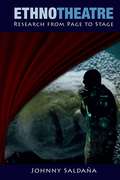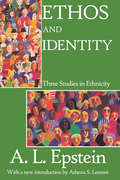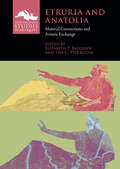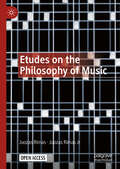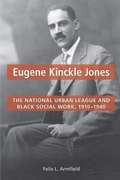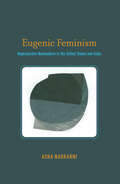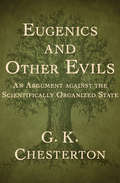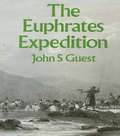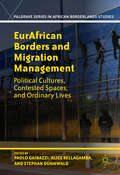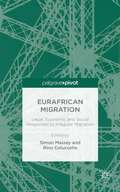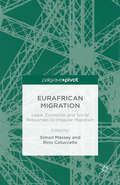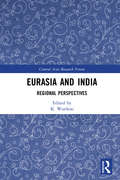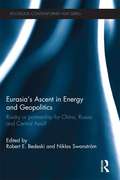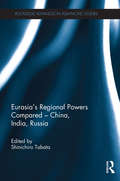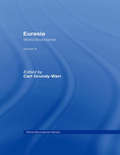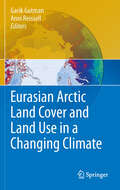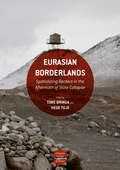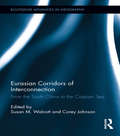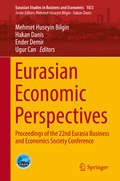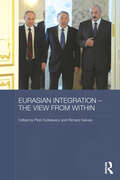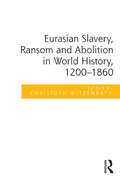- Table View
- List View
Ethnotheatre: Research from Page to Stage (ISSN)
by Johnny SaldañaEthnotheatre transforms research about human experiences into a dramatic presentation for an audience. Johnny Saldaña, one of the best-known practitioners of this research tradition, outlines the key principles and practices of ethnotheatre in this clear, concise volume. He covers the preparation of a dramatic presentation from the research and writing stages to the elements of stage production. Saldaña nurtures playwrights through adaptation and stage exercises, and delves into the complex ethical questions of turning the personal into theatre. Throughout, he emphasizes the vital importance of creating good theatre as well as good research for impact on an audience and performers. The volume includes multiple scenes from contemporary ethnodramas plus two complete play scripts as exemplars of the genre.
Ethnotheatre: Research from Page to Stage (Qualitative Inquiry and Social Justice)
by Johnny SaldañaEthnotheatre transforms research about human experiences into a dramatic presentation for an audience. Johnny Saldaña, one of the best-known practitioners of this research tradition, outlines the key principles and practices of ethnotheatre in this clear, concise volume. He covers the preparation of a dramatic presentation from the research and writing stages to the elements of stage production. Saldaña nurtures playwrights through adaptation and stage exercises, and delves into the complex ethical questions of turning the personal into theatre. Throughout, he emphasizes the vital importance of creating good theatre as well as good research for impact on an audience and performers. The volume includes multiple scenes from contemporary ethnodramas plus two complete play scripts as exemplars of the genre.
Ethos and Identity: Three Studies in Ethnicity
by Alan MerriamEthos and Identity asks the ever-puzzling question: What is ethnicity and how is it to be explained? In a new introduction to this work, Athena Leoussi describes Epstein's response to this challenging age-old query, and demonstrates why this classic volume is of continuing importance.Originally published thirty years ago, Ethos and Identity still fascinates the twenty-first century reader. Epstein's volume explains ethnic revivals of the past century, while the new introduction discusses those that occurred after the book's original publication, such as during the collapse of the communist Eastern bloc in the 1990s. Epstein offers insight into other ethnic reawakenings, such as that experienced during the late 1960s and early 1970s after the collapse of post-colonial east Asia. Prior to this, in the late 1940s and early 1950s, following World War II and the establishment of the United Nations, it was expected that ethnic identifications would be superseded by a more modern, universalistic, rational, civic- or class-based form. This did not occur. Instead, as nations collapsed and were reborn in new forms, people continued to identify with their ethnicity in describing themselves, even when their countries, at least as they knew them, no longer existed. In short, people and their cultures live on long after political and national boundaries have disappeared and been redrawn. Epstein's decisive contribution to the understanding of ethnicity proposes a "social anthropology of affect." People incorporate the social structure of ethnicity into the makeup of their personality and, thus, self-identification.Ethos and Identity is sure to interest students of anthropology, sociology, psychoanalysis, psychology, and ethnicity.
Etruria and Anatolia: Material Connections and Artistic Exchange
by Elizabeth P. Baughan Lisa C. PieracciniStriking similarities in Etruscan and Anatolian material culture reveal various forms of contact and exchange between these regions on opposite sides of the Mediterranean. This is the first comprehensive investigation of these connections, approaching both cultures as agents of artistic exchange rather than as side characters in a Greek-focused narrative. It synthesizes a wide range of material evidence from c. 800 – 300 BCE, from tomb architecture and furniture to painted vases, terracotta reliefs, and magic amulets. By identifying shared practices, common visual language, and movements of objects and artisans (from both east to west and west to east), it illuminates many varied threads of the interconnected ancient Mediterranean fabric. Rather than trying to account for the similarities with any one, overarching theory, this volume presents multiple, simultaneous modes and implications of connectivity while also recognizing the distinct local identities expressed through shared artistic and cultural traditions.
Etudes on the Philosophy of Music
by Juozas Rimas Juozas Rimas Jr.Drawing on the author's four decades of experience as a concert oboist, this open access book studies a number of foundational issues in the philosophy of music, such as musical meaning and expression, musical ontology and the existence of the musical work, the relation between music and language, and the phenomenology of music. The book surveys the development of Western classical music from the Baroque era through to the 20th century, both from the perspective of contemporary Lithuanian philosophers such as Girnius, Maceina, Šliogeris, and Jackūnas, and 20th century European philosophy. In addition to discussing key questions in the philosophy of music, the book also analyses technical musical terms such as articulation, phrasing, and rhythm.
Eu Prometi Não Contar: Criando uma Criança Transgênero
by Cheryl B. EvansLivro vencedor da medalha de bronze em 2017 do site Readers' Favorite. Quando você tem uma filha menina, você planeja muitas coisas para o seu future, exceto que ela se torne um menino. Este livro auxiliará qualquer um que queira aprender mais sobre disforia de gênero e é leitura obrigatória para pais, familiares ou amigos de uma pessoa que esteja questionando seu gênero ou que seja transgênero. Escrito por uma Mãe, este relato profundamente pessoal trata da descoberta do filho que ela nunca soube que havia tido. Sincero, comovente e bem escrito, você não ficará desapontado! “Eu prometi não contar é muito possivelmente um dos livros mais importantes da atualidade sobre uma questão social muito controversa e pouco compreendida: pessoas transgêneros. Tenho certeza de que você ficará impressionado não só com a coragem de Jordan ao longo do livro, mas também com o amor que Cheryl e seu esposo têm pelos seus filhos e sua compaixão para com todas as pessoas. Eu amei ‘Eu Prometi Não Contar’. Eu não conseguia largar o livro. É uma leitura altamente recomendável.” ~ Viga Boland, Readers Favorite com 5 Estrelas! O que faz deste relato único é que ele conta a história de uma criança transgênero desde o seu nascimento até os seus dezoito anos. Você terá uma boa ideia pelo que esta família passou. O esforço desesperado do filho tentando seguir as normas sociais de gênero, a tentativa de suicídio, as dificuldades de um membro da família conciliando Deus e uma pessoa transgênero, uma morte de partir o coração e muito mais. Cada passo da transição de seu filho de menina a menino (FTM) é discutido em detalhe, incluindo a terapia de reposição hormonal e as cirurgias de redesignação de sexo. Este livro compartilha todas essas informações na esperança de fazer a diferença no que parece ser um mundo duro e cruel para pessoas transgêneros. A jornada dessa família foi contada nas muitas
Eudora Welty and Mystery: Hidden in Plain Sight (Critical Perspectives on Eudora Welty)
by Jacob Agner and Harriet PollackContributions by Jacob Agner, Sarah Gilbreath Ford, Katie Berry Frye, Michael Kreyling, Andrew B. Leiter, Rebecca Mark, Suzanne Marrs, Tom Nolan, Michael Pickard, Harriet Pollack, and Victoria RichardEudora Welty’s ingenious play with readers’ expectations made her a cunning writer, a paramount modernist, a short story artist of the first rank, and a remarkable literary innovator. In her signature puzzle-texts, she habitually engages with familiar genres and then delights readers with her transformations and nonfulfillment of conventions. Eudora Welty and Mystery: Hidden in Plain Sight reveals how often that play is with mystery, crime, and detective fiction genres, popular fiction forms often condescended to in literary studies, but unabashedly beloved by Welty throughout her lifetime. Put another way, Welty often creates her stories’ secrets by both evoking and displacing crime fiction conventions. Instead of restoring order with a culminating reveal, her story-puzzles characteristically allow mystery to linger and thicken. The mystery pursued becomes mystery elsewhere. The essays in this collection shift attention from narratives, characters, and plots as they have previously been understood by unearthing enigmas hidden within those constructions. Some of these new readings continue Welty’s investigation of hegemonic whiteness and southern narratives of race—outlining these in chalk as outright crime stories. Other essays show how Welty anticipated the regendering of the form now so characteristic of contemporary women mystery writers. Her tender and widely ranging personal correspondence with the hard-boiled American crime writer Ross Macdonald is also discussed. Together these essays make the case that across her career, Eudora Welty was arguably one of the genre’s greatest double agents, and, to apply the titles of Macdonald’s novels to her inventiveness with the form, she is its “underground woman,” its unexpected “sleeping beauty.”
Eugene Kinckle Jones: The National Urban League and Black Social Work, 1910-1940
by Felix L. ArmfieldA leading African American intellectual, Eugene Kinckle Jones (1885-1954) was instrumental in professionalizing black social work in America. Jones used his position was executive secretary of the National Urban League to work with social reformers advocating on behalf of African Americans and against racial discrimination. He also led the Urban League's efforts at campaigning for equal hiring practices and the inclusion of black workers in labor unions, and promoted the importance of vocational training and social work. Drawing on interviews with Jones's colleagues and associates, as well as recently opened family and Urban League archives, Felix L. Armfield blends biography with an in-depth discussion of the roles of black institutions and organizations. The result is a work that offers new details on the growth of African American communities, the evolution of African American life, and the role of black social workers in the years before the civil rights era.
Eugenic Feminism: Reproductive Nationalism in the United States and India
by Asha NadkarniAsha Nadkarni contends that whenever feminists lay claim to citizenship based on women&’s biological ability to &“reproduce the nation&” they are participating in a eugenic project—sanctioning reproduction by some and prohibiting it by others. Employing a wide range of sources from the United States and India, Nadkarni shows how the exclusionary impulse of eugenics is embedded within the terms of nationalist feminism.Nadkarni reveals connections between U.S. and Indian nationalist feminisms from the late nineteenth century through the 1970s, demonstrating that both call for feminist citizenship centered on the reproductive body as the origin of the nation. She juxtaposes U.S. and Indian feminists (and antifeminists) in provocative and productive ways: Charlotte Perkins Gilman&’s utopian novels regard eugenic reproduction as a vital form of national production; Sarojini Naidu&’s political speeches and poetry posit liberated Indian women as active agents of a nationalist and feminist modernity predating that of the West; and Katherine Mayo&’s 1927 Mother India warns white U.S. women that Indian reproduction is a &“world menace.&” In addition, Nadkarni traces the refashioning of the icon Mother India, first in Mehboob Khan&’s 1957 film Mother India and Kamala Markandaya&’s 1954 novel Nectar in a Sieve, and later in Indira Gandhi&’s self-fashioning as Mother India during the Emergency from 1975 to 1977.By uncovering an understudied history of feminist interactivity between the United States and India, Eugenic Feminism brings new depth both to our understanding of the complicated relationship between the two nations and to contemporary feminism.
Eugenics and Other Evils: An Argument against the Scientifically Organized State (Mobi Classics Ser.)
by G. K. ChestertonG. K. Chesterton's highly influential treatise on one of the most controversial topics of the early twentieth century When G. K. Chesterton first published Eugenics and Other Evils in 1922, he seemed to be the lone voice of reason against the fashionable concept of selectively breeding a population for "desirable" traits. Though later generations came to associate eugenics with the horrors of the Third Reich, worldwide support for the philosophy was at an all-time high when Chesterton penned this brave and prophetic work. His unique combination of somber analysis and coruscating wit produces an argument too persuasive to ignore. Eugenics and Other Evils showcases Chesterton at the height of his rhetorical powers. His discussion of capitalism, socialism, and the concerns that guide our moral decisions is as pertinent today as the day it was penned. This ebook has been professionally proofread to ensure accuracy and readability on all devices.
Euphorias in Gender, Sex and Sexuality Variations: Positive Experiences
by Tiffany JonesThis Open Access book uses the concept of ‘euphoria’ to investigate when, why and how marginal gender, sex and sexuality groups have positive experiences of their diverse variations even within repressive and disordering contexts. Drawing on data from multiple online surveys including a study of 2,407 LGBTQ+ people and a study of 272 people with intersex variations, it names and offers a new ecological framework for understanding participants’ influences on and barriers to euphorias, asserting the subversive possibilities of being euphorically queer, as opposed to euphoric and queer. The author argues that it is the particularities of negative internal, socio-cultural and institutional contexts for a marginal group or groups that contributes towards the possibilities that shape their potential euphoric feelings and experiences. Ultimately, she calls for a more expansive focus in gender and sexuality studies to show the complex effects of dysphoria and repression on the possibilities of pleasure and joy.This book will be of interest to scholars across Gender, Sexuality and Queer Studies.
Euphrates Expedition
by John. S. GuestFirst published in 1992. This book invites the reader to cast the mind a hundred and fifty years back to a short span of time between 1829 and 1842. This was an exciting period when Britain’s might, demonstrated to the world at Trafalgar and Waterloo, was fortified by leadership in steam technology and was given a new direction by the liberal philosophy that British statesmen, thinkers and poets proclaimed at home and abroad. The Euphrates expedition was an attempt by well-intentioned British governments to achieve a geopolitical end by a technological means. The objective was to halt Russian expansion in the Near East, where some observers saw a threat to Britain’s control of India.
EurAfrican Borders and Migration Management: Political Cultures, Contested Spaces, and Ordinary Lives (Palgrave Series in African Borderlands Studies)
by Paolo Gaibazzi, Stephan Dünnwald and Alice BellagambaThis volume traces the African ramifications of Europe’s southern border. While the Mediterranean Sea has become the main stage for the current play and tragedy between European borders and African migrants, Europe’s southern border has also been “offshored” to Africa, mainly through cooperation agreements with countries of transit and origin. By bringing into conversation case studies from different countries and disciplines, this volume seeks to open a window on the backstage of this externalization of borders. It casts light on the sites – from consulates to open seas and deserts – in which Europe’s southern border is made and unmade as an African reality, yielding what the editors call "EurAfrican borders." It further describes the multiple actors – state agents, migrants, smugglers, activists, etc. – that variously imagine, construct, cross or contest these borders, and situates their encounters within the history of uneven exchanges between Africa and Europe.
Eurafrican Migration: Legal, Economic And Social Responses To Irregular Migration
by Rino Coluccello Simon MasseyInformed by witness testimonies, Eurafrican Migration details how the perilous journeys undertaken by irregular migrants are enabled by complex networks of guides during the Sahara phase, and explores the relationship between migrants and the criminal groups who arrange for them to be transported across the sea to southern Europe.
Eurafrican Migration: Legal, Economic and Social Responses to Irregular Migration
by Rino Coluccello Simon MasseyInformed by witness testimonies, Eurafrican Migration details how the perilous journeys undertaken by irregular migrants are enabled by complex networks of guides during the Sahara phase, and explores the relationship between migrants and the criminal groups who arrange for them to be transported across the sea to southern Europe.
Eurasia and India: Regional Perspectives (Central Asia Research Forum)
by K. WarikooEurasia has assumed importance in the post-Soviet period and the peoples of Siberia have distinctive historico-cultural similarities with the Indian Himalayas due to common traditions and Buddhist culture. The Eurasianism of Russia brings it closer to India in historico-cultural, political and economic terms. Another important player in Eurasia is Kazakhstan, which has been highlighting the importance of Eurasianism. These relations provide an opportunity for India to engage in collaborative endeavours with the Eurasian countries. This book provides detailed analyses on the historico-cultural linkages between Eurasia (Buryatia, Khakassia ,Tuva and Altai Republics of Russian Federation) and India through history. It also examines the process of the revival of indigenous traditions in the region in the post-Soviet period, the importance of the Eurasian vector in Russian and Kazakhstan’s foreign policy and the development of the Eurasian Economic Union and the implications this will have for India. Eminent academics and area specialists from Buryatia, Altai, Khakassia, Moscow, Kazakhstan and India have contributed to this book which provides a first hand view of the linkages between India and the Siberian region of India. Eurasia and India also includes rare photographs of the traces of Indian culture in Siberia. Offering a new understanding of the significant and strategic Indian ties to Eurasian states, this book will be of interest to academics studying Eurasian and Central Asian society and geopolitics, International Relations and South and Central Asian Studies.
Eurasia's Ascent in Energy and Geopolitics: Rivalry or Partnership for China, Russia, and Central Asia? (Routledge Contemporary Asia Series)
by Robert E. Bedeski Niklas SwanströmThe Sino-Russian relationship has experienced several permutations in recent decades as both states have undergone radical domestic changes, including the end of Soviet communism and the abandonment of Maoism. This volume brings together scholars to address the current status of Sino-Russian relations in the political, military, energy and trade sectors. In this comprehensive new volume, authors offer a detailed account on the both the historical context and current status of relations between Russia and China and the geo-political realignments in Eurasia. This analysis of the evolving relationship addresses global strategy, energy politics, national security, human security, and Central Asian links. Individual chapters examine key issues such as China’s economic ascendancy, military relations, the geostrategic position of Mongolia, Japan’s views and historical background. With authors representing a broad range of current active experts and researchers working in Europe, the US, Central Asia, China and Japan, this book offers a long-term and in-depth analysis of the relations and potential developments in both bilateral and international relations. This work will be of great interest to scholars of international relations, Asian security, and the Eurasian region.
Eurasia's Regional Powers Compared - China, India, Russia (Routledge Advances in Asia-Pacific Studies)
by Shinichiro TabataTaking a long view, and a wide perspective, this book by Japan's leading scholars on Asia and Eurasia provides a comprehensive and systematic comparison of the three greatest powers in the region and assesses how far the recent growth trajectories of these countries are sustainable in the long run. The book demonstrates the huge impact on the region of these countries. It examines the population, resource and economic basis for the countries' rise, considers political, social and cultural factors, and sets recent developments in a long historical context. Throughout, the different development paths of the three countries are compared and contrasted, and the new models for the future of the world order which they represent are analysed.
Eurasia: World Boundaries Volume 3 (World Boundaries Series #Vol. 3)
by Carl Grundy-WarrEurasia offers a wide-ranging and original interpretation of territory, boundaries and borderlands in Europe, Asia and the Far East. This forms part of a unique series of books focussing on world boundaries which embrace the theory and practice of boundary delimitation and management, boundary disputes and conflict resolution, and territorial change in the new world order.
Eurasian Arctic Land Cover and Land Use in a Changing Climate
by Garik Gutman Anni ReissellThis volume is a compilation of studies on interactions of land-cover/land-use change with climate in a region where the climate warming is most pronounced compared to other areas of the globe. The climate warming in the far North, and in the Arctic region of Northern Eurasia in particular, affects both the landscape and human activities, and hence human dimensions are an important aspect of the topic. Environmental pollution together with climate warming may produce irreversible damages to the current Arctic ecosystems. Regional land-atmosphere feedbacks may have large global importance. Remote sensing is a primary tool in studying vast northern territories where in situ observations are sporadic. State-of-the-art methods of satellite remote sensing combined with GIS and models are used to tackle science questions and provide an outlook of current land-cover changes and potential scenarios for the future. Audience: The book is a truly international effort involving U.S. and European scientists. It is directed at the broad science community including graduate students, academics and other professionals in this field.
Eurasian Borderlands: Spatializing Borders in the Aftermath of State Collapse (Approaches to Social Inequality and Difference)
by Tone Bringa and Hege TojeThis book examines changing and emerging state and state-like borders in the post-Soviet space in the decades following state collapse. This book argues border-making is not only about states’ physical marking of territory and claims to sovereignty but also about people’s spatial practices over time. In order to illustrate how borders come about and are maintained, this book looks at border communities at internal, open administrative borders and borders in the making, as well as physically demarcated international state borders. This book also pays attention to both the spatial and temporal aspects of borders and the interplay between boundaries and borders over time and thus identifies some of the processes at play as space is territorialized in Eurasia in the aftermath of state collapse.
Eurasian Corridors of Interconnection: From the South China to the Caspian Sea (Routledge Advances in Geography #10)
by Corey Johnson Susan M. WalcottConnectivity, as well as conflict, characterizes Eurasia. This edited volume explores dynamic geopolitical and geo-economic links reconfiguring spaces from the eastern edge of Europe through the western edge of Asia, seeking explanation beyond description. The ancient Silk Road tied together space, much as pipelines, railroads, telecommunications infrastructure, and similar cultural and constructed links ease the mobility of people and products in modern Eurasia. This book considers Eurasia along an interlinked corridor, with chapters illustrating the connections as a discussion foundation focusing on the shared interactions of a set of nation states through time and across space, generating more positive considerations of the resurgently important region of Eurasia. China’s interests fall into three chapters: the southeastern border with Vietnam, the southwestern Himalayan edge, and the western Muslim regions. Russia’s recovery relates events to a larger landmass context and focuses on the importance of historic mobility. A geo-history of the Caspian considers this petroleum-rich area as a zone of cultural and economic interconnection. The final focus on Central Asia treats the traditional heart of “Eurasia”. The concluding chapter pulls together strands linking subregions for a new concept of “Eurasia” as an area linked by vital interests and overlapping histories.
Eurasian Economic Perspectives: Proceedings of the 22nd Eurasia Business and Economics Society Conference (Eurasian Studies in Business and Economics #10/2)
by Mehmet Huseyin Bilgin Hakan Danis Ender Demir Ugur CanThis volume of Eurasian Studies in Business and Economics includes selected papers from the 22nd Eurasia Business and Economics Society (EBES) Conference in Rome. It gathers scholarly contributions on the latest applied economics research from developing countries such as Croatia, Poland, the Baltic and ASEAN countries, which tend to be underrepresented in the current literature. Both the theoretical and empirical papers in this volume cover diverse areas of economic research from various regions. The main focus is on sharing the latest findings on empirical industrial organization, in particular the economics of innovation, regional economic development dynamics, and banking sector reforms in developing countries.
Eurasian Integration - The View from Within (Routledge Contemporary Russia and Eastern Europe Series)
by Richard Sakwa Piotr DutkiewiczAs Eurasia and the adjacent territories become more important to the world, there is increasing interest from international powers, accompanied by attempts to give institutional form to traditional economic and security links within the region. This book includes a range of substantive work from scholars based in the region, offering contrasting perspectives on the process of Eurasian integration and its place in the world. Chapters consider economic, political, social and security developments, with notable studies of the major countries involved in the development of the Eurasian Economic Union. The work also examines the connections between the region and China, greater Asia and the European Union. It outlines the varying dynamics, with populations growing in Central Asia while at best stagnant elsewhere. The book discusses the increasing strategic significance of the region and explores how the new post-Soviet states are growing in national cohesion and political self-confidence. Above all, the book examines the concept of ’Eurasia’, outlining the debates about the concept and how various aspects of the legacy of ‘Eurasianism’ contribute to contemporary plans for integration. The book argues that although regional integration is very much a popular idea in our age, with the potential for economic benefits and increased international influence, in practice contemporary projects for Eurasian integration have been highly ambiguous and contested. Nevertheless, significant steps have been taken towards the creation of the Eurasian Economic Union. The book analyses developments to date, noting the achievements as well as the challenges.
Eurasian Slavery, Ransom and Abolition in World History, 1200-1860
by Christoph WitzenrathRecent research has demonstrated that early modern slavery was much more widespread than the traditional concentration on plantation slavery in the context of European colonial expansion would suggest. Slavery and slave trading, though little researched, were common across wide stretches of Eurasia, and a slave economy played a vital part in the political and cultural contacts between Russia and its Eurasian neighbours. This volume concentrates on captivity, slavery, ransom and abolition in the vicinity of the Eurasian steppe from the early modern period to recent developments and explores their legacy and relevance down to the modern times. The contributions centre on the Russian Empire, while bringing together scholars from various historical traditions of the leading states in this region, including Poland-Lithuania and the Ottoman Empire, and their various successor states. At the centre of attention are transfers, transnational fertilizations and the institutions, rituals and representations facilitating enslavement, exchanges and ransoming. The essays in this collection define and quantify slavery, covering various regions in the steppe and its vicinity and looking at trans-cultural issues and the implications of slavery and ransom for social, economic and political connections across the steppe. In so doing the volume provides both a broad overview of the subject, and a snapshot of the latest research from leading scholars working in this area.
